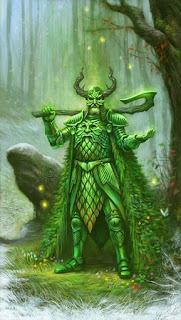Sir Gawain and the Green Knight

The story begins at Christmastime at King Arthur’s court in Camelot. The Knights of the Round Table join Arthur in the holiday celebrations, and Queen Guinevere presides in their midst. The lords and ladies of Camelot have been feasting for fifteen days, and now it is New Year’s Day. Everyone participates in New Year’s games, exchanging gifts and kisses. When the evening’s feast is about to be served, Arthur introduces a new game: he refuses to eat his dinner until he has heard a marvelous story. Be careful for you wish for. While the lords and ladies feast, with Arthur’s nephew Gawain and Guinevere sitting together in the place of privilege at the high table, Arthur continues to wait for his marvel. As if in answer to Arthur’s request, an unknown knight suddenly enters the hall on horseback. The gigantic knight has a beautiful face and figure. Every piece of his elaborate armor is green, with flourishes of gold embossing. His huge horse is green, and his green hair and beard are...







